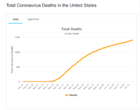Good idea. Why don't you beat me to it?
-
Here's a chart that will be interesting to watch. I have aligned Florida's numbers with those of New York at the point they each crossed a 7 day MA of confirmed new cases of 1150. So for NY this was, obviously, very early on: March 20. FL didn't get to this point until a couple of weeks after Miami-Dade "reopened": June 8. FL's case count rate really inflected a few days later but this will do. (By the third week of June FL tracks NY closely.)
New York, despite the warnings from Europe, got slammed for many reasons including, arguably, denial of threat, population density and commuter behavior, unprepared hospitals, unprepared population etc. The death rate rose rapidly with case count, with a week or so lag. Lessons were rapidly being learnt and a shut down pulled the rug out from under the tsunami. New case count 7DMA peaked on April 10. Death count 7DMA peaked 3 days later. Note how the death rate then fell relatively faster than new case count, likely as hospitals put in place better procedures, received more PPE, learnt lessons in patient handling etc.
During this period, the sunshine state was on a slow burn. Daily case counts were modest as was the daily rate of death. A lock-down undoubtedly made things easier and provided time for hospitals to prepare, for the public or at least some of it to realize the threat, for many businesses to adjust to WFH etc. (BTW our office building is still only about 25% of normal capacity.) While FL had a lot more deaths under its belt than NY by the time the 7DMA new confirmed case count hit 1154 on June 8 - 2,715 deaths had been racked up - the 7DMA death rate was still down at 37. (NY went from a 7DMA of 15 on March 20 to 39 three days later.) Hospitals down here have learnt a lot of tidbits from their colleagues up north: better intake and patient segregation procedures, more plentiful PPE, placing patients struggling to take in enough oxygen on their stomachs, waiting as long as possible before putting patients on ventilators, use of steroids and new drugs like Remdesivir. There's a great article in today's FT discussing some of the lessons learnt and how doctors have used social media to get the message out - well worth a read.
So far so good for FL. But, as the chart highlights, FL is in new territory with respect to daily confirmed case count and it shows no signs yet of rolling over. The rate of hospitalization is such that FL hospitals are now straining massively. (Keeping people alive longer in hospital is a double-edged sword as capacity fills up.) While nothing like NY, the 7DMA of deaths has tripled in less than a month to a level of 95 (versus yesterday's death toll of 156). The median age of new confirmed cases has for the last few days been running at 40/41 versus a median age of all cases to date of 39 so it's not just a bunch of young people getting it. Dr Leora Horwitz, an associate professor population health and medicine at NYU Langone Health and author of a study discussed in the FT article said: "In New York, the health system was overwhelmed and that is happening in the south now. Some of the bad outcomes we are going to see are because they can't cope with the volume." She added: "None of this is to say [mortality] won't be lower - I hope it will be - but it's not going to be by a big magnitude."
Of course the charts don't take account of population or case demographics, although the two state's populations aren't massively different (10%). FL has a higher median age of 42 vs NY's 39.
Gonna be interesting...














